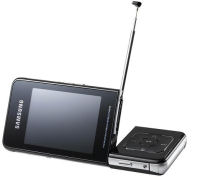Samsung, Nokia Partnership on DVB-H Signals Battleground Shift
Much of the focus of this year's National Association of Broadcasters convention in Las Vegas this week will be on differing standards for digital broadcasting. Although US terrestrial broadcasters are gearing up for a permanent transition to the new digital spectrum in just under two years' time, considerable scrutiny is being given to the entry into the North American market of digital, portable TV services that have already taken root in Europe and Asia - especially Korea - not just for their portability but as potential alternate channels for TV content distribution.
So this morning's announcement by Samsung and Nokia - considered rivals in the portable phone manufacturing market - of cooperation toward the development of a key standard arising from Europe's DVB-H specification, is a bit of a wake-up call. Samsung is perceived as one of the driving forces behind the popularity of DMB, the most prevalent digital portable broadcast standard in Korea, while Nokia has been the champion of DVB-H in Europe.
The two companies haven't exactly been at odds with one another; Samsung does produce DVB-H phones, including models that were among the first to utilize the more common CDMA transmission standard. And both companies are members of the Mobile DTV Alliance, which marshals the DVB-H specification and its associated standards, as well as the Open Mobile Alliance (OMA), which drives standardization of mobile data services.
But this new partnership is a critical next step, and perhaps a realization on Samsung's part that DMB - the service deployed by Virgin Mobile in Europe - may never command a majority stake of that market, despite its recent successes.
What Samsung and Nokia are pledging today is to work together toward driving development and adoption of something called OMA Broadcast Enabler (OMA BCAST), which would be a technology that facilitates and secures streaming media in a uniform fashion across many different digital broadcast transmission layers. With the "O" standing for "open," that currently includes DVB-H as well as 3GPP and 3GPP2...but not yet DMB.
Perhaps more importantly for American customers, that "O" does not include MediaFLO, the digital broadcast standard presently under way for adoption here by AT&T and Verizon Wireless. Qualcomm is not only the champion but the creator of MediaFLO, holding its technology secrets tightly to its war chest along with the rest of its patent portfolio. Maybe you've read: Qualcomm and Nokia don't get along very well right now.
What Samsung and Nokia may have realized is that, for carriers to want to adopt DVB-H long-term, they will need to present more similar handset profiles that match carriers' transmission capabilities.
As Samsung's senior vice president Kwang Suk Hyun stated today, "inclusion in our product portfolios will enhance our customers' flexibility in choosing suitable standards based on their business models." OMA BCAST may also have the virtue of expanding Samsung's reach to more regions that carriers may serve, while at the same time continuing to exclude its clear rivals.
At the same time, OMA BCAST would help endow digital broadcasting with some critical services that basic terrestrial digital TV presently lacks, including a built-in programming guide, per-customer service provisioning, an interactive feedback channel for individual customers.
 And if you caught earlier our reference to the phrase "securing content," you know exactly where we're leading with this: Mobile TV vendors currently perceive OMA BCAST among other DRM options for encrypting streaming content, not only preventing copying of that content but securing the session by which that content is delivered. As OMA BCAST's architects explain it, mobile TV customers don't want malware broadcast to their consoles, masquerading as programming.
And if you caught earlier our reference to the phrase "securing content," you know exactly where we're leading with this: Mobile TV vendors currently perceive OMA BCAST among other DRM options for encrypting streaming content, not only preventing copying of that content but securing the session by which that content is delivered. As OMA BCAST's architects explain it, mobile TV customers don't want malware broadcast to their consoles, masquerading as programming.
The implication here is, once viewers become acquainted with the threat of "broadcast malware," they'll ask for content protection explicitly.
Two months ago, Samsung introduced for the European market the innovative F510 DVB-H receiver, with a swivel display that lets it become a tabletop device for a hotel or a moving train. It will be interesting to see how soon Samsung endows a device at the F510's level with OMA BCAST support.
